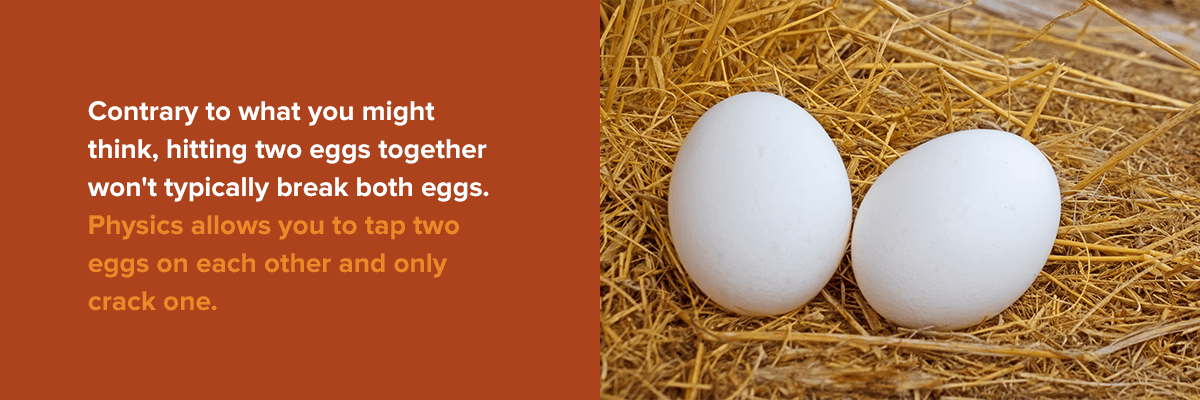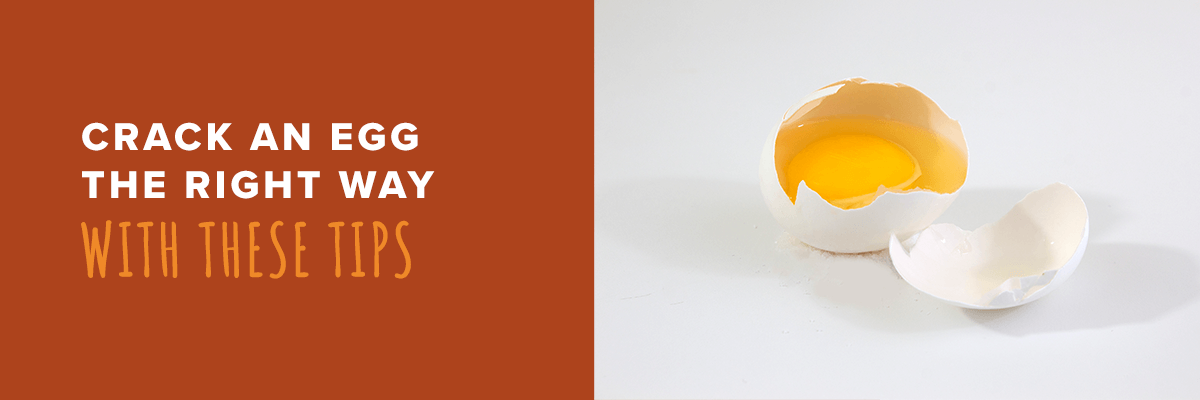How to Crack an Egg (the Right Way)
Posted on: November 21st 2022

Cracking an egg seems simple enough, but it’s easy to find yourself frustrated with broken yolks, bits of shell, and a slimy mess when trying to work with eggs. Eggs are fragile, and it’s easy for things to go wrong when cracking your eggs. We’ve compiled the best ways to crack an egg and other tips so you can elevate your kitchen skills and become an egg-cracking pro in no time.
How to Crack an Egg
Hone your cooking preparation abilities with some of these ways to crack eggs:
On the Countertop
The countertop is one of the best ways to crack an egg. Cracking eggs often leads to the shell shattering and contaminating the egg, forcing you to dig around in the sticky mess for a few small, slippery shell pieces. If you crack your eggs on a raised or ridged surface — like a bowl’s lip — you’re pushing the shell and protective membrane into the egg, increasing your chances of a shell in your egg.
Prevent this by cracking your eggs on your flat countertop. While this might seem like a recipe for disaster at first, you’re unlikely to end up with eggs splattered all over your counter. Take your egg in one hand and firmly but carefully tap it on the countertop. Stop when you see a vertical crack form in the shell. Once you see this, you can take your fingers and separate the egg halves into your bowl.
On the Side of the Bowl
While the side of the bowl isn’t the easiest way to get a shell-free crack, it’s a tried-and-true method for egg cracking. If you don’t want to crack your egg on the countertop, you can use the edge of your bowl. Make sure you’re hitting the middle of the egg on the bowl’s rim — this helps you create an even, cleaner split and gives you more control when pulling the egg apart with your hands.
Take the egg in one hand and tap it on the side of your bowl several times. Once the shell cracks, you can split the egg into the bowl. Watch out for any shell pieces that might have fallen into the bowl. You’ll need to scoop these out to avoid contaminating your food.
With a Knife
If you’re wondering how to crack an egg with more control, try using a knife. This can help you achieve a more consistent crack if you aren’t the best at cracking with your hands. Place the egg in your palm with the pointy end facing your fingertips. Use an icing spatula or butter knife to strike the egg across the middle — try to do it with a quick flicking motion. A firm, fast strike will swiftly crack the egg without smashing it.
Hit Two Eggs Together

Contrary to what you might think, hitting two eggs together won’t typically break both eggs. Physics allows you to tap two eggs on each other and only crack one. To do this, take one egg in each hand and gently tap the eggs together at their midpoints. One of the eggs will crack, and you can go ahead with splitting the cracked egg for your dish.
This method is best if you plan to use two eggs. You don’t want to mistakenly crack the second one by hitting them together too hard and put it back in the fridge.
How to Crack an Egg With One Hand
Learning to break eggs with one hand is the way to go if you want to level up your egg-cracking abilities. One-handed egg cracking allows you to increase your cracking speed, which is especially handy if you’re using lots of eggs for one recipe. It’s a little tricky to explain, so grab some eggs and prepare to get a little messy as you test this method out.
Take the egg in one hand and grip it around one side with your thumb, index, and middle fingers. At the same time, hold the wider bottom end with your pinky and ring fingers. You’re going to use your fingers to crack the egg — essentially, you’re pulling in one direction with your thumb and pulling in the other direction with your index and middle fingers.
There should be a middle section of the egg that remains uncovered by your fingers — crack this section on a surface and then pry the egg open with your thumb, index, and middle fingers. Your pinky and ring fingers act more like stabilizers on the bottom part of the egg as you pop off the top. Pour the egg into a bowl and check for bits of shell, especially if this is one of your first attempts at cracking an egg with one hand.
With enough tries, you’ll find out how to make this method work for you. Once you get the hang of it, you’ll be cracking eggs one-handed in rapid succession in no time.
How to Crack an Egg Without Breaking the Yolk
There is no way to guarantee an unbroken yolk — they sometimes just happen. However, gently cracking your egg on a flat surface and carefully pulling it apart will help prevent broken yolks and shells in your eggs. Don’t grip the egg halves too tightly — hold them firmly and then smoothly insert your thumbs into the crack to break the egg membrane and release the yolk and whites. Your yolk should come out cleanly. If it doesn’t, turn the mistake into delicious scrambled eggs!
What Is the Best Way to Crack an Egg?
The best way to crack an egg is the method that works for you. Don’t try to do anything overly complicated or straining. Pick the method that you find most comfortable and that allows you to get the most consistent results. While the flat surface method is the best for preventing the shell from crushing into the egg, it might not be the easiest for you. Test out different styles and perfect your preferred method for the best results.
Most Common Mistakes to Avoid When Cracking Eggs
Here are some of the most common missteps people make when cracking their eggs:
- Cracking already-cracked eggs: Eggshells protect the egg from bacteria, dirt, and contamination. If your egg already has a crack, you should avoid eating it. The egg might have harmful bacteria inside that could make you sick.
- Cracking too hard: Putting too much force behind your cracking will cause the egg to burst and make a mess everywhere. Apply firm and swift pressure without smashing the egg.
- Cracking inward: If you break your egg with inward force, it will push the shell into the egg and egg membrane. Instead, pull the egg halves outward as you break the egg to keep the egg yolk and shell separate.
- Cracking over your pan or bowl: Never crack eggs directly into your cooking preparations. If your yolk breaks, you get shell in there, or you have a bad egg, you might’ve ruined the rest of your ingredients — a disaster if you’re trying to nail a difficult egg dish on your own. Always crack your egg into a separate bowl or container so you can check its quality before cooking. This tip is especially helpful if you need to separate the yolk from the white, like in an egg white cocktail.
What to Do if You Get Shell in the Eggs
If you get some shell in your egg, don’t panic. While you don’t want to eat the shell, it can be tricky to scoop out. Avoid using just your fingers or utensils — the shell will just swim away from you. Instead, use another piece of shell to scoop it out. The shells will grip each other easily, so you can remove the bits without stress. If you already threw out the shell, you can wet your fingertip and try to coax the shell out. The water helps attract the shell to your finger.
Once you remove the eggshell from the egg, you can reuse the shell in a variety of ways, so nothing goes to waste.
Crack an Egg the Right Way with These Tips

Practice your egg-cracking skills with healthy, delicious eggs from Sauder’s Eggs. As a family-owned business, we work closely with our suppliers to ensure our eggs are high-quality and fresh for our customers daily. If you’re looking for premium, tasty eggs for your home, check out one of our retailers and pick up our products in stores today! Then, put your skills to the test with our delicious recipes.
